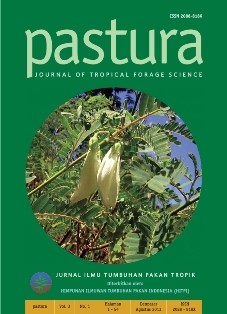KOMPOSISI KIMIAWI DAN KECERNAAN INVITRO SILASE HIJAUAN GEMBILINA (Gmelina arborea) MENGGUNAKAN INOKULUM Lactobacillus collinoides DAN Lactobacillus delbrueckii
Abstract
The purpose of this research is to know an effect of the lactate acid bacteria inoculants of toward Gmelina arborea forage as feeding material.The significance of this research is hopefully as direction and information about using Gmelina arborea forage effectively and efficiently. The research was experimental method by completely randomized design. In the type of inoculants treatment is Lactobacillus collinoides, Lactobacillus delbrueckii, the mixture (compounding between Lactobacillus collinoides, Lactobacillus delbrueckii 1:1), and giving treatment to the incubation length for about 2, 3, 5, 10, 15 and 21 days in the nested of bacterial types factorial. Each treatment is repeated for 3 times. The result showed that lactic acid bacteria inoculant affects affected to the content of NDF, ADF, cellulose, and affected in invitro dry matter digestibility (IVDMD) and invitro organic matter digestibility (IVOMD) of Gmelina arborea forage as well. The Lactobacillus delbrueckii inoculant is the most effective to defend the lost of NDF, ADF and cellulose, and to defend the decrease of IVDMD and IVOMD during ensilages. The bacterial inoculums Lactobacillus delbrueckii is able to accelerate quality reduction stagnation of NDF, ADF and cellulose, and IVDMD and IVOMD for five days, while others for ten days. It is suggested to obtain good forage ensiling in Gmelina arborea forage, it is better to use Lactobacillus delbrueckii inoculant.Downloads
Download data is not yet available.
How to Cite
MUWAKHID, Badat; SJOFJAN, Osfar; AULANI’AM, -.
KOMPOSISI KIMIAWI DAN KECERNAAN INVITRO SILASE HIJAUAN GEMBILINA (Gmelina arborea) MENGGUNAKAN INOKULUM Lactobacillus collinoides DAN Lactobacillus delbrueckii.
Pastura, [S.l.], v. 3, n. 1, june 2014.
ISSN 2549-8444.
Available at: <https://ojs.unud.ac.id/index.php/pastura/article/view/9056>. Date accessed: 24 dec. 2025.
doi: https://doi.org/10.24843/Pastura.2013.v03.i01.p10.
Issue
Section
Articles
Keywords
ensilage, forage, lactate acid bacteria





